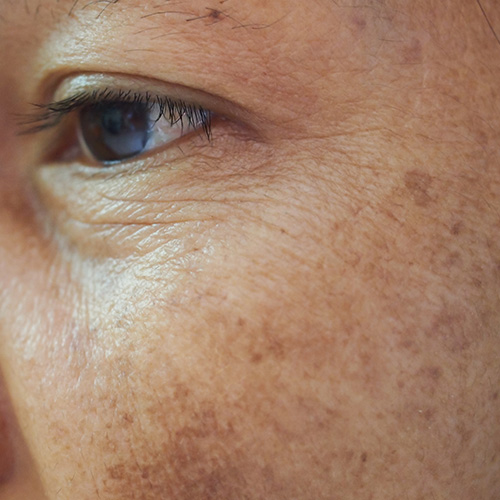Brown spots and sun damage are common skin conditions that are often caused by prolonged exposure to the sun’s UV rays. Brown spots, also known as age spots or liver spots, are flat, pigmented areas of skin that can appear on various parts of the body, while sun damage can cause wrinkles, fine lines, rough texture, and hyperpigmentation. Both conditions can be aesthetically displeasing and can increase the risk of skin cancer. Prevention is key when it comes to brown spots and sun damage, and measures such as wearing protective clothing and sunscreen, as well as avoiding prolonged exposure to the sun, can help prevent these conditions from occurring.
Sun damage is caused by exposure of the skin to ultraviolet A (UVA) and ultraviolet B (UVB) rays, which cause cumulative damage to all skin types throughout the lifespan. Sunburns and tanning cause impaired skin function/repair, skin hyperpigmentation, redness caused by increased inflammation, and genetic changes in our skin due to UV radiation. The damage to unprotected skin from radiation exposure shows up in our late 40s to 50s as our skin evolves. Applying broad spectrum (blocks UVA and UVB rays) SPF and covering sun-exposed skin is the only way to protect against the effects of the sun, and it’s never too late to slow down damage.

+ IPL (Intense Pulsed Light)
+ Photofractional
+ Metvix Photodynamic Therapy
+ Custom Resurfacing
+ Laser Vein Treatment
+ Benign Lesion Removal
+ Microlaser Peel
+ Jessner Peel
+ PRP (Platelet Rich Plasma) Treatment
+ Microneedling
+ Monthly or quarterly at home skin examinations
+ Annual examinations with a dermatologist or family doctor
Skin damage from the sun, or photodamage, is caused by exposure to UV radiation emitted from UVA and UVB rays from the sun. Brown spots result from damage to melanocytes, which are the skin cells responsible for creating melanin. Melanin acts as a natural “sunscreen” for us, and it is what’s responsible for the tan after sun exposure. The tan and sunburn may be temporary, but the damage has already been done.
Any person who has sun-damaged skin or has a history of actinic keratoses (textured skin growths caused by sun exposure) may benefit from visiting a dermatologist for a full-body exam every 6-12 months, or sooner if concerning changes to lesions occur.
Yes, UV radiation can penetrate clouds and cause sun damage even on cloudy days. It’s important to wear sunscreen and protective clothing every day, regardless of the weather.
While it’s not possible to completely reverse sun damage, there are treatments available that can improve the appearance of sun-damaged skin. These treatments include chemical peels, laser therapy, and microdermabrasion.
While most brown spots are harmless, some can be a sign of skin cancer. It’s important to monitor any changes in the size, shape, or color of your brown spots, and to consult with a dermatologist if you notice any concerning changes.
PRODUCT RECOMMENDATIONS
November 24 – December 1st
Save up to 25% OFF SKIN gift cards and use them on your favourites all year long.